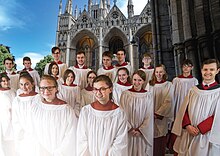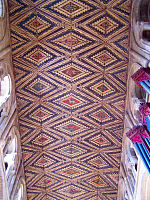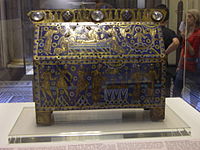Peterborough Cathedral
| Peterborough Cathedral | ||
|---|---|---|
| The Cathedral Church of St Peter, St Paul and St Andrew | ||
Canon Missioner Steve Benoy (designate) | | |
| Laity | ||
| Director of music | Tansy Castledine | |
| Organist(s) | Christopher Strange (Organist) Vacant (Organ Scholar) | |
Peterborough Cathedral, properly the Cathedral Church of St Peter, St Paul and St Andrew, formerly St Peter's Abbey and also still known as St Peter's Cathedral in the
Peterborough Cathedral is known for its imposing Early English Gothic West Front (façade) which, with its three enormous arches, is without architectural precedent and with no direct successor. The appearance is slightly asymmetrical, as one of the two towers that rise from behind the façade was never completed (the tower on the right as one faces the building), but this is only visible from a distance.
History
Anglo-Saxon origins
The original church, known as "
In the mid-10th century monastic revival (during which churches at Ely and Ramsey were also refounded) a Benedictine Abbey was created and endowed in 966, principally by Athelwold, Bishop of Winchester, from what remained of the earlier church, with "a basilica [church] there furbished with suitable structures of halls, and enriched with surrounding lands" and more extensive buildings which saw the aisle built out to the west with a second tower added. The original central tower was, however, retained.[4] It was dedicated to St Peter and surrounded by a palisade, called a burgh, hence the town surrounding the abbey was eventually named Peter-burgh. The community was further revived in 972 by Dunstan, Archbishop of Canterbury.[2][5]
This newer church had as its major focal point a substantial western tower with a "Rhenish helm" and was largely constructed of ashlars.[citation needed] Only a small section of the foundations of the Anglo-Saxon church remain beneath the south transept but there are several significant artefacts, including Anglo-Saxon carvings such as the Hedda Stone, from the earlier building.
In 2008, Anglo-Saxon grave markers were reported to have been found by workmen repairing a wall in the cathedral precincts. The grave markers are said to date to the 11th century, and probably belonged to "townsfolk".[6]
Norman and medieval architectural evolution


Although damaged during the struggle between the
The church was largely built of Barnack limestone from quarries on its own land, and it was paid annually for access to these quarries by the builders of Ely Cathedral and Ramsey Abbey in thousands of eels (e.g. 4,000 each year by Ramsey).[9] Cathedral historians believe that part of the placing of the church in the location it is in is due to the easy ability to transfer quarried stones by river and then to the existing site allowing it to grow without being relocated.
Then, after completing the Western transept and adding the Great West Front Portico in 1237, the medieval masons switched over to the new


The trio of arches forming the Great West Front, the defining image of Peterborough Cathedral, is unrivalled in medieval architecture. The line of spires behind it, topping an unprecedented four towers, evolved for more practical reasons. Chief amongst them was the wish to retain the earlier Norman towers, which became obsolete when the Gothic front was added. Instead of being demolished and replaced with new stretches of wall, these old towers were retained and embellished with cornices and other gothic decor, while two new towers were added to create a continuous frontage.
The
Monastic life

The existing mid-12th-century records of
The supposed arm of
These items underpinned the importance of what is today Peterborough Cathedral. At the zenith of its wealth just before the Reformation it had the sixth-largest monastic income in England, and had 120 monks, an
Tudor
In 1541, following Henry VIII's dissolution of the monasteries, the relics were lost. The church survived by being selected as the cathedral of the Anglican Diocese of Peterborough. Henry's former wife, Catherine of Aragon, had been buried there in 1536. To this day, her grave is honoured by visitors who decorate it with flowers and pomegranates (her symbol). The gold letters at the site read "Katharine Queen of England", a title she was denied at the time of her death. A festival to commemorate the Queen is held yearly.
In 1587, the body of
Civil War to present


The cathedral was vandalised during the
Some of the damage was repaired during the 17th and 18th centuries. Extensive restoration work began in 1883, which was initiated after large cracks appeared in the supporting pillars and arches of the main tower. These works included rebuilding of the central tower and its foundations, interior pillars, the choir and re-enforcements of the west front under the supervision of John Loughborough Pearson. New hand-carved choir stalls, cathedra (bishop's throne), choir pulpit and the marble pavement and high altar were added. A stepped level of battlements was removed from the central tower, reducing its height slightly.
The cathedral was hit by a fire on the early evening of 22 November 2001; it is thought to have been started deliberately amongst plastic chairs stored in the North Choir Aisle.[11] Fortunately the fire was spotted by one of the vergers allowing a swift response by emergency services.[12] The timing was particularly unfortunate, for a complete restoration of the painted wooden ceiling was nearing completion.[13] The oily smoke given off by the plastic chairs was particularly damaging, coating much of the building with a sticky black layer.[14] The seat of the fire was close to the organ and the combination of direct damage from the fire, and the water used to extinguish necessitated a full-scale rebuild of the instrument, putting it out of action for several years.
An extensive programme of repairs to the west front began in July 2006 and has cost in excess of half a million pounds. This work is concentrated around the statues located in niches which have been so badly affected by years of pollution and weathering that, in some cases, they have only stayed intact thanks to iron bars inserted through them from the head to the body. The programme of work has sought donors to "adopt a stone".[15]
The sculptor Alan Durst was responsible for some of the work on the statues on the West Front.[16]
Choir

There has been a choir at Peterborough Cathedral since its beginnings as a monastery.
Misericords
The Peterborough Cathedral most probably had a set of over thirty misericords dating from the fourteenth century. However, only three now survive.[17]
Dean and chapter
As of 1 January 2022:[18]
- Dean – Chris Dalliston (since 20 January 2018 installation)[19]
- Vice Dean and Canon Pastor – Tim Alban Jones (since 2015; Acting Dean, 2017–2018; Acting Precentor, 2017–2018; Vice Dean since February 2018;Diocesan Canon}, 2015–2021; full-time since 1 January 2022)[21]
- Canon Precentor – Rowan C. Williams (since 16 September 2018 installation)[22]
- Canon Missioner and Bishop's Chaplain (Diocesan Canon) – Steve Benoy (1 May 2022 onwards)[23]
- one Diocesan Canon vacancy – previously held by Dean of Newport, 22 May 2021
Burials
This section needs additional citations for verification. (February 2019) |

- King Penda of Mercia). Kyneburga (d. c. 680) founded an Abbey for both monks and nuns in Castor, becoming the first Abbess (Kyneswide succeeded her). Kyneburga was buried in her church, but both of their remains were later translated (before 972) to Peterborough Abbey, now Peterborough Cathedral, along with those of their kinswoman, Tibba. Kyneburga became revered as a saint soon after her death. Her remains were moved once more to Thorney Abbeysome time later. All three women are considered Saints.
- Ælfric Puttoc (died 1051), medieval Archbishop of York and Bishop of Worcester
- Ralph the Timid (died 1057), Earl of Hereford and nephew of Edward the Confessor
- Cynesige, Archbishop of York (1051–1060)
- Ralph the Staller (c. 1011–1068), (in the Abbey)
- Alexander of Holderness, 12th century Abbot of Peterborough
- Catherine of Aragon (1485–1536), Queen of England, first wife and queen-consort of Henry VIII
- Mary, Queen of Scots (1542–1587), following execution at nearby Fotheringhay Castle, was buried in Peterborough between 1587 and 1612, before being disinterred and reinterred in Westminster Abbey
- John Chambers, first Bishop of Peterborough (1541–1556)
- Robert Scarlett ("Old Scarlett") (1496–1594), sexton of Peterborough Cathedral, who dug graves for both Catherine of Aragon and Mary, Queen of Scots, during many years of service (just inside the Cathedral)[24][25]
- Richard Howland, Bishop of Peterborough (1584–1600)
- Francis Dee, Bishop of Peterborough (1634–1638)
- John Towers, Bishop of Peterborough (1639–1649)
- John Hinchliffe, Bishop of Peterborough (1769–1794)
- William Connor Magee, Bishop of Peterborough and Archbishop of York (1821–1891)
- Rev Lewis Clayton
- Bishop Spencer Madan
- Bishop John Hinchliffe
- Richard Cumberland (philosopher)
- Mandell Creighton (d.1901) Bishop of Peterborough
- Bishop William Connor Magee, Archbishop of York
Other Memorials

- George Alcock (1912-2000) astronomer
- Edith Cavell, nurse executed by the Germans
- William Clavell Ingram, Dean of Peterborough
- Francis Jeune (1806-1868) Bishop of Peterborough
- Bishop Spencer Leeson (window)
- Arthur Richard Sculthorpe (1903-1974) campaigner for the deaf-blind
- Bill Westwood (1925-1999), Bishop of Peterborough
- Sgt Thomas Hunter of Kurri Kurri, New South Wales
Reliquary at Peterborough
A number of saints were interred in the altar at Peterborough[26]
Gallery
-
Partial elevation
-
17th-century view
-
View from the south east, c. 1898, after the 1880s rebuilding
-
The Hedda Stone. An 8th-century Anglo-Saxon carving from the original church.
-
The hanging crucifix or rood designed by George Pace in 1975, the figure of Christ is by Frank Roper.
-
Painted nave ceiling.
-
The cathedral as represented on the frieze around the Royal Albert Hall
-
French enamelled casket made c. 1180 for Benedict to take some relics of Thomas Becket to Peterborough Abbey when he became its Abbot. As Prior of Canterbury Cathedral he had witnessed Becket's assassination in 1170. The casket is now in the Victoria and Albert Museum, London. In 2018, it was on temporary display in Peterborough Museum to celebrate the 900th anniversary of the completion of the Cathedral in 1118.
Cathedral music
Organ
https://www.peterborough-cathedral.org.uk/home/musichome/worship-and-music/organ.aspx
Organists
The records of organists at Peterborough Cathedral list Richard Storey as organist in 1540. Notable organists of Peterborough Cathedral have included
Lists of incumbents
- List of bishops of Peterborough
- List of deans of Peterborough
- List of abbots of Peterborough
See also
- List of Gothic cathedrals in Europe
- List of cathedrals in the United Kingdom
- Peterborough Chronicle
- The King's School, Peterborough
- Architecture of the medieval cathedrals of England
- English Gothic architecture
- Romanesque architecture
- Church of England
- List of ecclesiastical restorations and alterations by J. L. Pearson
References
- ^ "Peterborough". Encyclopædia Britannica. Encyclopædia Britannica Online. 2009. Archived from the original on 30 January 2010. Retrieved 5 March 2009.
- ^ a b c Sweeting, W.D (5 October 2004) [1898]. "Chapter 1. History of the Cathedral Church of St Peter". In Bell, E (ed.). The Cathedral Church of Peterborough: A Description of its Fabric and a Brief History of the Episcopal See. Bell's Cathedrals (Project Gutenberg transcription of the 1926 reprint of the 2nd ed.). London: G. Bell and Sons. Archived from the original on 29 September 2007. Retrieved 23 April 2007.
- ^ http://cambridgemilitaryhistory.com/2014/11/30/the-hedda-stone-and-peterborough-abbey/ Archived 8 December 2014 at the Wayback Machine The Hedda Stone and Peterborough Cathedral at the Cambridge Military History Website
- ISBN 0-520-06388-0. Retrieved 25 April 2007.
He restored Peterborough Abbey to its former royal splendor and dedicated "a basilica there furbished with suitable structures of halls, and enriched with surrounding lands."
- ^ The most recent survey of the Anglo-Saxon history of Peterborough Abbey is in Kelly, S.E. (ed.), Charters of Peterborough Abbey, Anglo-Saxon Charters 14, OUP, 2009.
- ^ Anglo-Saxon graves found at Peterborough Cathedral. Medievalists.net. Retrieved on 15 May 2008. Archived 1 October 2011 at the Wayback Machine
- ^ "Peterborough Cathedral". Eastern Cathedrals. Archived from the original on 11 May 2019. Retrieved 11 May 2019.
- ^ The others are at Zillis, Switzerland, Hildesheim in Germany and Dädesjö, Sweden. The longest of these is less than half the length of Peterborough's ceiling.
- ^ Beeke, Clive (2006). "Abbots of Ramsey". Ramsey Abbey website. Clive Beeke. Archived from the original on 10 March 2007. Retrieved 23 January 2007.
Edward [the Confessor] also became a party to an agreement between the Abbot of Ramsey and Abbot of Burgh (Peterborough) in regard to the exchange of lands; to bounds and limits of King's-delf; also the right to Ramsey Abbey to dig stone both 'squared and broken' at the quarries of Barnack. For this privilege the Abbey had to give the Monks of Peterborough 'four thousand eels yearly in Lent'
- ISBN 0-500-25087-1.
- ^ "CATHEDRAL FIRE: Candle theory on cathedral arson". Peterborough Evening Telegraph. Johnston Press Digital Publishing. 27 November 2006. Archived from the original (Newspaper) on 30 September 2007. Retrieved 23 January 2007.
- ^ "FIRE: 'I watched the beautiful building go up in smoke'". Peterborough Evening Telegraph. Johnston Press Digital Publishing. 23 November 2006. Archived from the original on 30 September 2007. Retrieved 23 January 2007.
- ^ "FIRE: Devestating blow to appeal work (sic)". Peterborough Evening Telegraph. Johnston Press Digital Publishing. 23 November 2006. Archived from the original on 28 September 2007. Retrieved 23 January 2007.
- ISBN 978-1-903470-55-8.
- ^ Adopt a Stone a gift to last a lifetime. Peterborough Cathedral 2013 (accessioned 20131229) [1] Archived 3 January 2014 at the Wayback Machine
- ^ Alan Durst, Mention of work on West Front.
- ^ Strange, Dominic. "The Misericords and history of Peterborough Cathedral". misericords.co.uk. Archived from the original on 12 October 2015. Retrieved 13 October 2015.
- ^ Peterborough Cathedral – Clergy, Chapter & Staff Archived 22 December 2021 at the Wayback Machine (Accessed 1 January 2022)
- ^ "Page not found – Peterborough Cathedral". peterborough-cathedral.org.uk. Archived from the original on 9 March 2019. Retrieved 16 February 2019.
{{cite web}}: Cite uses generic title (help) - ^ "Vice Dean appointed to Peterborough Cathedral – Peterborough Cathedral".
- ^ "Canon Tim to take up full-time Cathedral role – Peterborough Cathedral".
- ^ "Rowan Williams to be new Canon Precentor and Bishop's Adviser for Liturgy and Worship – Peterborough Cathedral". peterborough-cathedral.org.uk. Retrieved 16 February 2019.
- ^ "Clergy, Chapter & Staff – Peterborough Cathedral".
- ^ "Site unseen: Peterborough Cathedral". The Independent. 27 June 1995. Archived from the original on 17 February 2019. Retrieved 16 February 2019.
- ^ "Shakespeare, Hamlet, Peterborough Cathedral and Old Scarlett". peterboroughtoday.co.uk. 13 July 2017. Archived from the original on 17 February 2019. Retrieved 16 February 2019.
- ^ a b Nicholas Brooks, Catherine Cubitt, St. Oswald of Worcester (Continuum, 1 January 1996) page 255
Further reading
- Peterborough Cathedral, 2001– 2006 : from devastation to restoration, Michael Bunker and Paul Binski, Paul Holberton Publishing, London (2006), ISBN 978-1-903470-55-8
- Peterborough Abbey, (2001), ISBN 0-7123-4710-0
External links
- Peterborough Cathedral The cathedral's website
- The Cathedral Church of Peterborough, by W.D. Sweeting, at Project Gutenberg
- The New Guide to Peterborough Cathedral, by George S. Phillips, at Project Gutenberg
- Peterborough Cathedral – The Complete Geometry 1100–1500
- Pictures of Peterborough
- Bill Thayer's site
- Peterborough Cathedral on Skyscrapernews.com Archived 21 October 2012 at the Wayback Machine
- Peterborough Cathedral at Structurae
- Adrian Fletcher’s Paradoxplace Peterborough Cathedral Pages – Photos
- Flickr images tagged Peterborough Cathedral
- The Hedda Stone and Peterborough Cathedral at the Cambridge Military History Website








